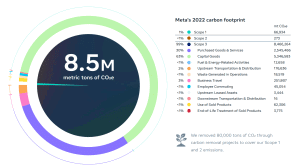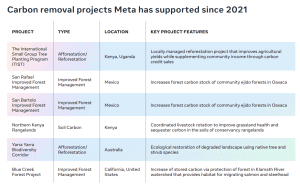Meta’s Earnings Surge Amid Strong Q2 Results
Meta’s shares surged about 5% in after-hours trading on Wednesday following a robust earnings report that exceeded analysts’ expectations for the second quarter. The company, which owns Facebook, Instagram, and WhatsApp, reported $39.07 billion in revenue and $5.16 earnings per share. Both surpassed market predictions of $38 billion in revenue and $4.7 earnings per share.
CEO Mark Zuckerberg highlighted the success of Meta AI and the company’s growth across its apps, including advancements in AI technology and Ray-Ban Meta AI glasses. The tech giant indicated that AI investments will be a significant driver of capital expenditure growth in 2025.
Meanwhile, other major tech companies have struggled recently, as their earnings reports didn’t show sufficient returns on their multibillion-dollar AI investments. This led to a decline in shares of Alphabet, Tesla, and Microsoft. But same with its peers, Meta is also faced with the biggest environmental challenge of tackling its growing carbon footprint, mainly due to AI.
How Does Meta Deal With Its Ambitious Net Zero Goal?
Meta, the world’s fifth-largest tech company, is tackling the challenge of sustainability with ambitious targets and bold actions. Having achieved net zero emissions in global operations by 2020, the company now aims to achieve net zero value chain emissions by 2030. This is a significant challenge, as 99% of Meta’s carbon footprint in 2022 came from Scope 3 emissions, which continue to rise.
Rachel Peterson, Vice President of Data Centre Strategy at Meta, acknowledged the difficulty of this task in the company’s 2023 Sustainability Report. She noted that Meta’s Scope 3 emissions are increasing as the company supports the global demand for its services.
Meta is addressing this challenge by focusing on efficiency, circularity, and low-carbon technology. Through its supplier engagement program, the company aims to decarbonize its supply chain and enable at least two-thirds of its suppliers to set Science Based Targets initiative (SBTi)-aligned reduction targets by 2026.
To reach its sustainability goals, Meta reduced operational emissions by 94% from a 2017 baseline, primarily by powering its data centers and offices with 100% renewable energy. These renewable energy commitments have resulted in a reduction of over 12.3 million metric tons of carbon dioxide equivalent (CO2e) since 2018.
Reducing Emissions
Reducing greenhouse gas (GHG) emissions across Meta’s global operations and value chain is a top priority and a critical strategy for reaching net zero. Meta recognizes that failing to reduce emissions today will result in a high-carbon intensity business model in the future.
Meta’s approach to emissions reduction is guided by several core principles:
- Choosing Better: Incorporating principles of circularity into the supply chain, construction, and purchases.
- Designing with Less: Reducing the volume of materials in construction and hardware, extending the life of hardware components, and minimizing waste.
- Embracing Low-Carbon Technology: Finding alternatives such as low-carbon fuels and innovative new materials.
Enabling Renewable Energy
Supporting Meta’s operations with 100% renewable energy is a critical component of the company’s net zero strategy. This task becomes increasingly challenging as the business grows.
Meta partners with many of the largest utilities in the U.S. to integrate renewable energy into their systems in ways that benefit both Meta and other customers. The tech giant’s portfolio of over 10,000 megawatts (MW) of contracted renewable energy projects positions it as one of the largest corporate buyers of renewable energy worldwide.
- In the U.S., Meta boasts the largest operating portfolio, with more than 5,500 MW of renewable energy capacity currently online. Meta’s renewable energy projects represent an estimated $14.2 billion in capital investment for new infrastructure.
Data Center Emissions
Facebook parent’s company focuses on circularity by designing hardware for efficiency and repairability. Its Design for Circularity guide integrates dematerialization, circular materials, reuse, and end-of-life principles. Key strategies include extending hardware lifespans, reusing components, and recycling end-of-life materials.
Meta partners with downstream firms to responsibly manage and repurpose residual materials, advancing its circular supply chain goals. Still, some emissions from hard-to-abate sectors will be difficult to reduce by the end of the decade. To address these, Meta has turned to carbon removal projects, a key component of its emissions reduction strategy.
Carbon Removal Credits: A Key to Slash Scope 3 Emissions
Meta’s diverse approach to carbon removal includes both nature-based and technological solutions. This strategy involves purchasing carbon credits from projects that align with Meta’s principles, ranging from reforestation to direct air capture technology.
Since 2021, Meta has supported numerous nature-based carbon removal projects worldwide. These include increasing forest carbon stock in community ejido forests in Oaxaca and protecting forests that provide habitat for salmon in California.
Demonstrating its commitment to nature-based solutions, Meta recently signed a major carbon credits deal for 6.75 million carbon credits with Aspiration, a leading provider of sustainable financial services. These credits come from various ecosystem restoration and natural carbon removal approaches, including reforestation, agroforestry, and sustainable agricultural practices.
Meta’s role in the voluntary carbon market extends beyond purchasing credits. The company also supports new project development through financing and encourages the evolution of standards to bring more certainty to the market.
Additionally, Meta collaborates with the World Resources Institute to develop methods for mapping forest canopy height using Meta AI training models. This initiative aims to provide publicly available data on forest canopy in areas like California and São Paulo, Brazil.
In 2022, Meta joined forces with other major tech companies to accelerate the development of carbon removal technologies by guaranteeing future demand. This effort, known as Frontier, is a $925 million joint commitment between Meta, Stripe, Shopify, McKinsey Sustainability, and Alphabet.
Meta’s strong financial performance and ambitious net zero goals underscore its commitment to innovation and environmental responsibility. As it continues to invest in AI and renewable energy and carbon removals, Meta is balancing its financial growth and environmental impact.



